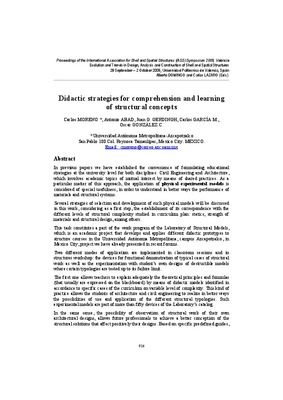|
Resumen:
|
In previous papers we have established the convenience of formulating educational
strategies at the university level for both disciplines: Civil Engineering and Architecture,
which involves academic topics of mutual ...[+]
In previous papers we have established the convenience of formulating educational
strategies at the university level for both disciplines: Civil Engineering and Architecture,
which involves academic topics of mutual interest by means of shared practices. As a
particular matter of this approach, the application of physical experimental models is
considered of special usefulness, in order to understand in better ways the performance of materials and structural systems.
Several strategies of selection and development of such physical models will be discussed in this work, considering as a first step, the establishment of its correspondence with the different levels of structural complexity studied in curriculum plan: statics, strength of materials and structural design, among others.
This task constitutes a part of the work program of the Laboratory of Structural Models,
which is an academic project that develops and applies different didactic prototypes to
structure courses in the Universidad Autónoma Metropolitana, campus Azcapotzalco, in
Mexico City, project we have already presented in recent forums.
Two different modes of application are implemented in classroom sessions and in
structures workshop: the devices for functional demonstration of typical cases of structural work as well as the experimentation with student's own designs of destructible models where certain typologies are tested up to its failure limit.
The first one allows teachers to explain adequately the theoretical principles and formulas
(that usually are expressed on the blackboard) by means of didactic models identified in
accordance to specific cases of the curriculum on variable level of complexity. This kind of practice allows the students of architecture and civil engineering to realize in better ways the possibilities of use and application of the different structural typologies. Such
experimental models are part of more than fifty devices of the Laboratory's catalog.
In the same sense, the possibility of observation of structural work of their own
architectural designs, allows future professionals to achieve a better conception of the
structural solutions that affect positively their designs. Based on specific predefined guides, the students develop their own architectural-structural projects and subject them to diverse loads, observing their behavior under the influence of variable stresses leading up the experiment to its last resistance.
From both experiences a significant learning is obtained for the student's formation and
training, who will be capable in his future professional work to use better tools of
comprehension of the structural concepts applied to architecture as well as of increasing his conscience of the benefits and convenience of multidisciplinary work.
[-]
|







